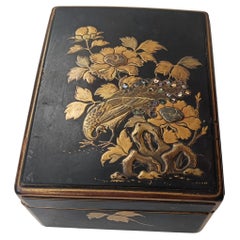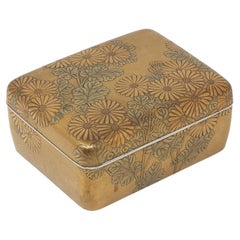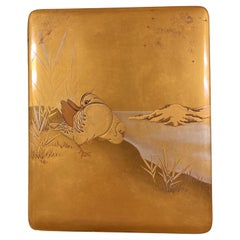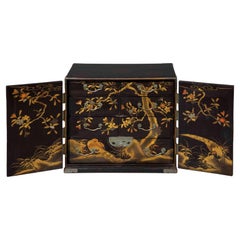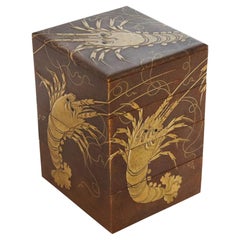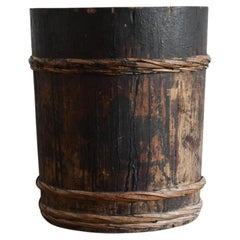Japanese Lacquer
to
17
153
69
257
2
1
2
1
36
132
89
3
52
15
5
6
1
6
2
1
2
3
210
122
70
32
17
525
458
260
193
41
260
259
259
1
1
1
1
1
Place of Origin: Japanese
Japanese Lacquered Wood Box 19th Century Asian Antiques 中国古董
Located in London, GB
Antique Japanese lacquered wood Box
Beautiful and elegant lacquered wood box and gold gilt, decorated with a crane with floral motives and Japanese script
Measures: Height 6 inches 1...
Category
19th Century Antique Japanese Lacquer
Materials
Wood, Lacquer
Important Japanese Lacquer Presentation Box Gifted by Japanese President to RAF
Located in Newark, England
PRESENTED BY THE 21ST PRESIDENT OF JAPAN
From our Japanese collection, we are absolutely delighted to bring to market this Important Japanese Lacquer Presentation Box. The Presentat...
Category
Early 20th Century Art Deco Japanese Lacquer
Materials
Lacquer
Japanese Lacquer Box with Mandarin Ducks
Located in Greenwich, CT
Japanese lacquer box with mandarin ducks motif on cover. One lacquer tray and one small lacquer plank inside the box.
Category
1930s Vintage Japanese Lacquer
Materials
Wood
19th Century Japanese Lacquer Table Cabinet
Located in Richmond, London
A fine and rare Japanese black lacquer table or jewellery cabinet, exquisitely decorated in intricate detail, dating to the late Meiji per...
Category
Late 19th Century Meiji Antique Japanese Lacquer
Materials
Metal
JAPAN Meiji Period 1870 Four Tiers Presentation Jubako Box Namiki Lacquer & Gold
Located in Miami, FL
Four Tier Japanese Gilt Jubako Maki-E box with red Interior.
This is a beautiful decorative presentation Jubako box created in the Imperial Japan during the early Meiji period (1868...
Category
1870s Meiji Antique Japanese Lacquer
Materials
Gold
Antique wooden bucket of Japanese lacquer craftsman/20th century/planter
Located in Sammu-shi, Chiba
This is a wooden bucket used by Japanese lacquerware craftsmen to store lacquer.
It is believed to have been used from the Meiji period to the first half of the Showa era (1868-1940)...
Category
Late 19th Century Meiji Antique Japanese Lacquer
Materials
Cedar, Lacquer
Japanese Lacquered Wood Bowls 19th Century Asian Antiques 中国古董
Located in London, GB
Fine Pair Japanese Lacquered Wood Bowls 19th Century Meiji
Beautiful and elegant example of Japanese lacquer ware with and gold gilt, Rice bowls ...
Category
19th Century Antique Japanese Lacquer
Materials
Wood, Lacquer
Japanese Lacquered Box Signed, Late 19th Century
Located in Beuzevillette, FR
Pretty Japanese lacquered box decorated with birds and foliage.
signed
Lacquered inside and outside
Late 19th century
Without key
Nice lock
Ideal for storing jewelry.
Category
Late 19th Century Antique Japanese Lacquer
Materials
Wood
Japanese Gold Lacquer Inro with Deer Image, Ojime, Wood Frog Netsuke, Makie Box
Located in Point Richmond, CA
The Inro is comprised of three stacked compartments and features a deer motif with mother of pearl accents, an ojime and a wooden frog netsuke. Inros were used to store items like m...
Category
1890s Meiji Antique Japanese Lacquer
Materials
Wood, Lacquer
Japanese Meiji Period Antique Lacquer Box with Gold Maki-e Decoration
Located in New York, NY
A fine antique Japanese Meji Period lacquer box decorated with a fan and a stylized star shaped window in the maki-e technique. The fan at the top right corner, fully opened depictin...
Category
19th Century Meiji Antique Japanese Lacquer
Materials
Lacquer
Japanese Lacquer Writing Box, Suzuribako, Edo Period, 18th Century, Japan
Located in Austin, TX
An exceptionally fine and unusual Japanese lacquer writing implements box, suzuribako, in the form of a zither, koto, Edo Period, 18th century, Japan. With a modern wood storage box,...
Category
18th Century Edo Antique Japanese Lacquer
Materials
Gold, Silver, Copper
Japanese Marquetry and Lacquer Jewelry Chest, Meiji Period, circa 1900, Japan
Located in Austin, TX
A very attractive Japanese wood table top jewelry or collector's chest with marquetry and lacquer decoration, Meiji period, circa 1900, Japan. Previously in the collection of Asbjorn Lunde (1927 - 2017).
The chest is crafted in the form of a Chinese seal...
Category
Early 1900s Meiji Antique Japanese Lacquer
Materials
Wood, Softwood, Lacquer
Portable jû'bako 重箱 (tiered food container)
Located in Amsterdam, NL
A rare, high quality lacquered portable jû'bako (tiered food container/stacked picnic box) fitted with a removable vertical safety bar - housing a nice secret – decorated with a refi...
Category
Late 19th Century Antique Japanese Lacquer
Materials
Brass
Fine Japanese Lacquer Takamakura Geisha Pillow, First Half of the 20th Century
Located in Ottawa, Ontario
A fine Japanese lacquer Takamakura Geisha pillow, first half of the 20th century. Depicting Shi-Shi Lion between peony and rock in gold, silver, red and ...
Category
Late 19th Century Japonisme Antique Japanese Lacquer
Materials
Abalone, Lacquer
A large square tray made of Japanese antique lacquer / Late Edo period/19th
Located in Sammu-shi, Chiba
These trays were made after the late Edo period in Japan (after 1800).
This particular type of tray is known as "Negoro-bon."
Negoro lacquerware is a specific style of Japanese lacqu...
Category
19th Century Edo Antique Japanese Lacquer
Materials
Lacquer
Miniature Japanese Hand Painted Wooden Laquered Set
Located in Long Island City, NY
A miniature Japanese set made of wood and lacquered in a classic black with gold accents and lacquered red interiors. The set consists of a variety of...
Category
Mid-20th Century Meiji Japanese Lacquer
Materials
Wood
$350 Sale Price / set
30% Off
Japanese Momoyama Period Black Lacquer and Mother of Pearl Box, 16th Century
Located in Austin, TX
A fine and unusual Japanese black lacquer and mother of pearl inlaid box, Momoyama Period, 16th century, Japan.
The large box and cover featu...
Category
16th Century Edo Antique Japanese Lacquer
Materials
Lacquer, Abalone
Japanese Maki Style Black Lacquer Effect Resin Two Trays Gold Painted Cranes
Located in Prato, Tuscany
We kindly invite you to read the full description, as we aim to provide detailed technical and historical information to ensure the authenticity of our pieces.
Unusual and refined pa...
Category
Mid-20th Century Japonisme Japanese Lacquer
Materials
Resin
Fine Miniature Japanese Kodansu with Lacquer Inlays
Located in Atlanta, GA
A fine Japanese miniature kodansu constructed from Kaki wood (Persimmon) circa 19th century, late Meiji period. With its expressive exotic wood grains and exposed tenon construction,...
Category
Late 19th Century Meiji Antique Japanese Lacquer
Materials
Wood
Japanese Maki-e Lacquer Stacking Box, Jubako, Meiji Period, Japan
Located in Austin, TX
A fine and impressive Japanese gold maki-e decorated black lacquer five-tier jubako with presentation tray, two lids, and the original tomobako storage box, Meiji period, late 19th c...
Category
Late 19th Century Meiji Antique Japanese Lacquer
Materials
Lacquer
Late 19th Century Japanese Kamakura Carved Lacquer & Wood Box
By The Lacquer Company
Located in Chapel Hill, NC
Late 19th century Japanese Kamakura carved lacquer & wood box. A bird perches in a flowering tree on the top surface. Often mistaken for Chinese carved lacquer. Good overall conditio...
Category
Late 19th Century Meiji Antique Japanese Lacquer
Materials
Wood, Lacquer
Japanese Lacquer Incense Box, Kogo, Momoyama or Edo Period, 16th/17th Century
Located in Austin, TX
A wonderful Japanese lacquer incense box, kogo, with a design of plovers in flight, late Momoyama or early Edo Period, circa 1600, Japan.
The small box, called a kogo, was used to s...
Category
Early 17th Century Edo Antique Japanese Lacquer
Materials
Gold, Pewter
Japanese Maki-e Lacquer Document Box, Edo Period, early 19th Century, Japan
Located in Austin, TX
A spectacular Japanese maki-e lacquer lidded box, possibly a writing box, suzuribako, decorated with images of folding fans, ogi, Edo Period, earl...
Category
Early 19th Century Edo Antique Japanese Lacquer
Materials
Coral
Japanese Lacquered Maki-E Natsume in Kodaiji Style
Located in Atlanta, GA
A Japanese lacquered tea caddy (known as Natsume) with fine Maki-e decoration circa 18-19th century Edo to Meiji period. The large-sized nat...
Category
19th Century Meiji Antique Japanese Lacquer
Materials
Wood, Lacquer
Pair of Large Antique Japanese Hokai Lacquer Boxes
Located in Atlanta, GA
A pair of Japanese lacquered lidded Hokai boxes with chased brass hardware and original ropes. Hokai boxes are traditionally used in Japan as the containers ...
Category
Early 20th Century Japonisme Japanese Lacquer
Materials
Wood, Lacquer
Beautiful Japanese Lacquered Tray Raden Abalone Shell Decoration
Located in Fukuoka, JP
Beautiful Japanese Lacquered Tray with Raden Abalone Shell Decoration
This beautiful Japanese lacquered tray is a stunning example of Japanese craftsmanship. It is made of high-quality wood and is decorated with abalone shell inlay, a technique known as raden. Raden is a centuries-old Japanese art form that involves inlaying mother-of-pearl, abalone shell, or other materials into a lacquer surface. The technique originated in China and was introduced to Japan in the Nara period...
Category
20th Century Japanese Lacquer
Materials
Lacquer
Antique Japanese Lacquer and Inlay Box from Ryukyu Island
Located in Atlanta, GA
A lacquer presentation box with mother-of-pearl inlays from Japanese Ryukyu Islands circa 17-18th century. The lidded box in rectangular form with rounded corner is a classic example...
Category
18th Century Japonisme Antique Japanese Lacquer
Materials
Mother-of-Pearl, Lacquer
Early 20th Century, Showa, Japanese Wooden Lacquered Lower Table / Stand
Located in Sampantawong, TH
Japanese wooden lacquered lower table / stand.
Age: Japan, Showa Period, Early 20th Century
Size: Length 51.8 C.M. / Width 33 C.M. / Height 12.7 C.M.
Condition: Nice condition overall.
Category
Early 20th Century Japanese Lacquer
Materials
Wood
$560 Sale Price
20% Off
Japanese Rinpa Style Lacquer Ink Stone Box Suzuribako
Located in Atlanta, GA
A Japanese writing box with ink stone (known as Suzuribako) with exquisite maki-e decoration circa late Meiji to early Taisho period (1890s-1930s)...
Category
Early 20th Century Japonisme Japanese Lacquer
Materials
Wood, Lacquer
Japanese Antique Lacquer Hair Comb with Flowers in Gold Maki-e
Located in New York, NY
Stunning antique Japanese lacquer hair comb with a geometric petal-like background of stylized chrysanthemums and flowers done in gold and red maki-e. Possibly Edo or Meiji time peri...
Category
Mid-19th Century Antique Japanese Lacquer
Materials
Giltwood, Lacquer
Antique Japanese Lacquer and Inlay Table from Ryukyu Islands
Located in Atlanta, GA
A small square-form table with lacquer and intricate mother-of-pearl inlay design from Ryukyu Islands kingdom circa 17-18th century. Ryukyuan kingdom was used to be an independent is...
Category
18th Century Edo Antique Japanese Lacquer
Materials
Mother-of-Pearl, Lacquer
Japanese Maki-e Lacquer Stack Box Jubako
Located in Atlanta, GA
An antique jubako (stack boxes) with five tiers in an elongated octagon shape circa 19th century (end of Edo or beginning of Meiji period). jubako was traditionally used to store and...
Category
19th Century Japonisme Antique Japanese Lacquer
Materials
Wood, Lacquer
Antique Japanese Inro by Shigehide Edo Period
Located in Atlanta, GA
This exquisite four-case lacquered inro was dated to the latter part of 18th century to early 19th century (Edo period) and made by Shigehide. The opposite sides of the inro together features a lavish flower arrangement in a bamboo basket (ikebana). The detailed craftmanship was a true pleasure to behold. Mostly Takamaki-e (high relief) were used to texturize the delicate petals of the chrysanthemums, on which different shades of gold were used to create contrast. Raden (mother of pearl) shells were also used to highlight some leaves, rendering the piece an interesting balance of color and material. The interior was completed in a mottled gold finish. It was signed Shigehide on the bottom with a Kao. There is a small carved rabbit ojime bead...
Category
Late 18th Century Japonisme Antique Japanese Lacquer
Materials
Wood, Lacquer
Japanese Lacquer and Cinnabar "Samurai" Cabinet, Inaba Family, Edo Period
Located in Troy, NY
Exceptionally large and rare lacquer cabinet. According to the heraldry, visible on the headgear in one of the panels, it was made for the Inaba family, a high ranking Daimyo family,...
Category
Late 19th Century Edo Antique Japanese Lacquer
Materials
Wood
Japanese Lacquer Meiji Period Cabinet on Stand, circa 1890
Located in Brighton, Sussex
A exquisite, fine quality Meiji period (1868-1912) Japanese black lacquer cabinet on stand with wonderful scrolling gilded decoration. H...
Category
Late 19th Century Japonisme Antique Japanese Lacquer
Materials
Lacquer
Antique Japanese Ink Stone Maki-e Lacquer Box Suzuribako Edo Provenance
Located in Atlanta, GA
A Japanese ink stone box (known as Suzuribako) with exquisite maki-e decoration from Edo period (circa mid-18th century). The box features a rectang...
Category
18th Century Edo Antique Japanese Lacquer
Materials
Wood, Lacquer
Exquisite Japanese Lacquer Maki-e Suzuribako by Koma Kyūhaku Edo Period
Located in Atlanta, GA
One of the finest Japanese Maki-e Suzuribakos (ink box) we have on offer, the roiro color box showcases an ambient nocturnal scene in which two shakudo inlaid crows perched on the handrails of a bridge (possible the Uji Bridge...
Category
Early 19th Century Japonisme Antique Japanese Lacquer
Materials
Stone, Metal
Signed Japanese White Lacquer and Maki-E Lacquer Tansu, Meiji Period
Located in Ottawa, Ontario
The case decorated overall in crackle-glaze white lacquer and fitted with a patinated metal carrying handle over three tiers of small drawers. The first two tiers are comprised of a ...
Category
Late 19th Century Meiji Antique Japanese Lacquer
Materials
Lacquer
Japanese Lacquer Tray with Maki-e and Inlay Hara Yoyusai Edo Period
Located in Atlanta, GA
A lovely Japanese lacquer rectangular lacquer tray with a slightly scalloped corner and four L shape supporting feet by one of the most celebrated lacquer artist active in Edo period Hara Yoyusai (1772-1845). Yoyusai lived in Edo (Tokyo) and worked under the patronage of Lord Matsudaira. He operated a large workshop and had a very prolific output of lacquer objects. Most survived pieces being inro...
Category
19th Century Japonisme Antique Japanese Lacquer
Materials
Wood, Lacquer
Antique Japanese Lacquer and Inlay Kang Table from Ryukyu Island
Located in Atlanta, GA
A small low table with lacquer and intricate mother-of-pearl inlay design from Ryukyu Islands kingdom circa 17-18th century. Ryukyuan kingdom was used to be an independent island cou...
Category
18th Century Edo Antique Japanese Lacquer
Materials
Mother-of-Pearl, Lacquer
Large Japanese Lacquer Document Box, Ryoshibako, Edo/Meiji period, Japan
Located in Austin, TX
A large and magnificently decorated Japanese lacquer document box, ryoshibako, signed Umeboshi/Baikyo, late Edo or early Meiji Period, mid 19th century, Japan.
The large document box, ryoshibako, of tall, rectangular shape with rounded corners, and fitted with an inrobuta (flush-fitting) cover with beveled edges. The exterior of this exquisite box is decorated all over with fifteen different raised reserves shaped as uchiwa (paddle) fans against a lush and intricate krikane ground imitating shagreen.
The uchiwa shaped reserves all of takamaki-e, and exquisitely painted with designs of animals, flowers, and landscapes in silver, gold, maki-e, hiramaki-e, and takamaki-e, with kirikane, nashiji, and polychrome embellishments, upon gold lacquer fudame grounds.
The interior of the lid is nothing short of spectacular, featuring a large design of a magnificent and beautifully detailed rooster and hen with chicks gathered around a lazy stream. Large stalks of chrysanthemum bloom behind them. All against an ethereal nashiji ground.
The cover of the box features five reserves:
1. Three minogame (turtles with long tails), symbolizing longevity
2. "Narihira Crossing the Sumida" from The Tales of Ise...
Category
1860s Meiji Antique Japanese Lacquer
Materials
Softwood, Lacquer
Japan 1800 Edo Period Six Drawer Inro In Lacquered Gilt Wood With Utensils
Located in Miami, FL
Japanese Inro from the Edo Period (1603-1867).
Beautiful Inro, created in Japan during the Edo period (Shogunate), circa 1800. It was carefully crafted in carved precious wood with ...
Category
Early 1800s Edo Antique Japanese Lacquer
Materials
Coral
Japanese Namban Chest adorned with cylindrical motives and mother of pearl inlay
Located in PARIS, FR
Small namban style chest with a semi-cylindrical lid made of black lacquered wood (urushi) with gold lacquer (maki-e) and inlaid with mother-of-pearl (raden).
Mon style decoration (...
Category
Mid-18th Century Antique Japanese Lacquer
Materials
Lacquer, Mother-of-Pearl
Japanese lacquer suzuri’bako 硯箱 (writing box) with shishi & Hotei design
Located in Amsterdam, NL
A captivating lacquer suzuri’bako (writing box) of rounded rectangular form depicting a pair of shishi (temple lions) and the lucky god Hotei 布袋 on a rôiro...
Category
Early 19th Century Antique Japanese Lacquer
Materials
Gold Leaf, Silver Leaf
Japanese Lacquer Sake Cups, Set of 3, Meiji Period, Early 20th Century, Japan
Located in Austin, TX
A finely decorated set of 3 red lacquer sake cups, sakazuki, featuring views of Mt. Fuji, Meiji period, circa 1900, Japan.
The lacquer sake cups, called sakazuki, of traditional p...
Category
Early 1900s Meiji Antique Japanese Lacquer
Materials
Lacquer
Japanese Antiques Mitamura Jiho Ivy Makie(Lacquer) Paper Box for calligraphy
Located in Niiza, JP
Mitamura Jiho 三田村自芳 Ivy Makie Lacquer Paper Box
290(W)× 130(H) × 365(D) [mm]
He have studied makie under Akatsuka Jitoku, the 8th master of the Edo makie Akatsuka school
He is an un...
Category
20th Century Japanese Lacquer
Materials
Wood, Lacquer
Japanese 19th Century Miniature Lacquer Chest with Waterfall
Located in Hudson, NY
Japanese 19th century miniature lacquer chest with waterfall. Late Edo to early Meiji period lacquer chest (mid to late 19th century) with two characters on the front reading Nuno an...
Category
Late 19th Century Antique Japanese Lacquer
Materials
Gold, Silver, Bronze
Japanese Laquered Tray finely Decorated , 19th Century Meiji Period
Located in Lincoln, Lincolnshire
This is a good papier mâché, circular, black lacquered tray, hand enameled and gilded, made in Japan during the 19th century, Meiji period.
This circular tray is very decorative, ...
Category
19th Century Meiji Antique Japanese Lacquer
Materials
Paper
Japanese 7-Pcs, Arita Sweetmeat Set & Matching Lacquer Box Meiji Period, 1880s
Located in Ottawa, Ontario
A seven-piece Japanese Arita Sweetmeat set and matching lacquer box, Meiji period (1880-1890). Comprising of a central hexagonal dish and six-fan shaped ...
Category
Late 19th Century Meiji Antique Japanese Lacquer
Materials
Porcelain, Lacquer
Uniquely Shaped Lacquer Box with Tachibana Clan Crests – 19th Century
Located in Fukuoka, JP
An impressive and unusually shaped Japanese lacquered box, bearing the gold crests of the prestigious Tachibana samurai clan. This elegant piece dates to the late Edo to early Meiji ...
Category
19th Century Edo Antique Japanese Lacquer
Materials
Wood, Lacquer
Japanese lacquer tebako 手箱 (box for personal accessories) with book design
Located in Amsterdam, NL
Superb rectangular black lacquer tebako (box for personal accessories) with a slightly domed well-fitted lid.
The lid has a continuous soft-tone multicoloured hiramaki-e (low-relief...
Category
Early 20th Century Japanese Lacquer
Materials
Lacquer
Japanese Tagasode (Whose Sleeves?) Lacquer Incense Box, Kobako, Meiji Period
Located in Austin, TX
A fine and unusual Japanese lacquer box for incense accessories, kobako, featuring a tagasode (whose sleeves?) design, Meiji Period, circa 1900, Japan.
The exquisite box of simple rectangular shape worked in maki-e lacquer, taka-maki-e, and raden, all against a lush ground of gold nashiji. Fitted with silver rims.
The main decorative element of the box depicts a six panel folding screen, byobu, showing an interior scene with kimono strewn over a rack, a motif known as tagasode (whose sleeves), all in raised taka-maki-e lacquer and inlaid raden.
The screen depicts an intimate room with tatami mats on the floor and sliding shoji doors in the background. The foreground depicts a large clothing...
Category
Early 1900s Meiji Antique Japanese Lacquer
Materials
Silver
Japanese Lacquer Suzuribako 硯箱 'Writing Box' by Hattori Toshio 服部俊夫 '1943'
By Hattori Toshio (Shunsho)
Located in Amsterdam, NL
A small Japanese black and gold lacquer suzuribako (writing box) with cartwheels in water, by the artist Hattori Toshio (1943).
Of rectangular form with rounded corners, bearing a lustrous rôiro ground throughout, the exterior sides of the box and exterior of the cover finely decorated in gold and little silver takamaki-e with cartwheels flowing in a dynamically executed body of water with many swirls
and gushes as well as scattered dew drops, the interior tray fitted with a rectangular ink stone and silver suiteki (waterdropper).
The underside signed ‘Toshi’.
With the original wooden tomobako with hakogaki reading Namikuruma makie suzuribako (The
writing box set, with a design of wheels in water), as well as a leaflet written in Japanese with the artist’s biography up to 1987.
Hattori Toshio (b. 1943), art name Hattori Shunsho, was first selected for the Nitten exhibition in Showa 38 (1963). Since then, he has exhibited more than twenty times at the Nitten and other exhibitions, winning numerous prestigious awards. In 1995,
he had an audience with Pope John Paul II and presented the Pope with a lacquer reading table. In 2004, he created the shelves for the guest room of the Kyoto State Guest House of the Government of Japan. He is a member of the Kyoto Crafts Artists Association, the Kyoto Lacquer...
Category
Late 20th Century Japanese Lacquer
Materials
Wood, Giltwood, Lacquer
Japanese Edo Period Lacquer and Mother-of-Pearl Embellished Stoneware Koro
Located in Austin, TX
A highly unusual Japanese crackle glazed koro (incense burner or censer), lacquered and inlaid with mother-of-pearl embellishment, signed Gyokusen, Ed...
Category
19th Century Edo Antique Japanese Lacquer
Materials
Copper
Antique Japanese Edo Makie Lacquered Stand Hibachi Brazier Tea Fire Bowl Brass
Located in Dayton, OH
Antique Japanese late Edo / Tokugawa period Hibachi used for burning coal, as a portable heater, and as a heating device for a pot of tea. In modern times they work well as a planter...
Category
19th Century Edo Antique Japanese Lacquer
Materials
Brass
$800 Sale Price
20% Off
Japanese Lacquer Incense Accessories Box, Kobako, Edo Period, mid 19th c, Japan
Located in Austin, TX
A remarkable Japanese maki-e lacquer box for incense accessories, kobako, with interior fitted tray, kakego, designed with a temple complex scene, late Edo Period, mid 19th century, ...
Category
Mid-19th Century Edo Antique Japanese Lacquer
Materials
Silk, Softwood, Cypress, Lacquer
Japan lake landscape kobako box lacquer - Edo
Located in PARIS, FR
Rectangular kobako box in takamaki-e and kirigane gold lacquer circled with pewter depicting a lake landscape. Inside and back of the box in nashi-ji lacquer.
Japan – Edo period (16...
Category
18th Century Antique Japanese Lacquer
Materials
Gold
Japanese Natsume or tea box adorned with mapple leaves and sakure flowers
Located in PARIS, FR
Natsume in dark red lacquer, decorated with autumn leaves and cherry blossoms in hiramaki-e and nashiji. Interior in black lacquer.
Maple leaves (Momiji) are celebrated in literature...
Category
Early 20th Century Taisho Japanese Lacquer
Materials
Gold
Japanese inro box in black and gold lacquer with a decor of snowy landscape
Located in PARIS, FR
Inrō with four boxes in black and gold lacquer, representing a person in a pavilion in a snowy landscape with mountain on the background. Realised in maki-e on black lacquer with sma...
Category
Late 18th Century Edo Antique Japanese Lacquer
Materials
Gold
Japanese lacquer suzuri’bako 硯箱 (writing box) with ‘Rinpa School’-style design
Located in Amsterdam, NL
Superb rectangular ‘Rinpa School’-style black lacquer suzuri’bako (writing box) with a slightly arched well-fitted overhanging cover with rounded corners.
The lid with a design of a gosho’guruma (ox-drawn carriage for Heian-era nobles) featuring golden hiramaki-e (low-relief lacquer design) and takamaki-e (high-relief lacquer design), inlays of lead and shiny mother-of-pearl (raden). The design continues along the sides.
The reverse of the lid decorated with two large curving pine trees (matsu) executed in the same way, but also with intricate dots of tiny pieces of inlaid blue mother-of-pearl along the golden trunk.
The interior shaped to hold various scholar’s accessories, including a partially gold lacquered inkstone (suzuri) and a bronze waterdropper (suiteki) shaped like a mythical minogame.
The interior inscribed ‘Hokkyô Kôrin zô’ (Made by Hokkyô Kôrin). Referring to the design being in style of the master Ogata Kôrin, but the actual lacquer artist is unknown. It is a homage to Kôrin by an artist that followed the school of Rinpa.
Including black lacquer wooden tomobako (tomobako).
The Rinpa School was a key part of the Edo period revival of indigenous Japanese artistic interests described by the term yamato-e. Paintings, textiles, ceramics, and lacquerwares were decorated by Rinpa artists with vibrant colours applied in a highly decorative and patterned manner. Favoured themes, which often contained evocative references to nature and the seasons, were drawn from Japanese literature, notably The Tale of Genji, The Tales of Ise...
Category
19th Century Antique Japanese Lacquer
Materials
Brass, Lead
Recently Viewed
View AllMore Ways To Browse
Large Japanese Lacquer Box
Meiji Japan Tray
Lacquered Japanese Bowl
Japanese Comb
Japanese Lacquered Miniature
Japanese Red Lacquer Tray
Japanese Lacquer Plaque
Large Cinnabar
Chinese Carved Cinnabar Red Lacquer
Korean Mother Of Pearl Furniture
Korean Mother Of Pearl
Japanese Lacquer Ware
Antique Chinese Cinnabar Lacquer
Japanese Lacquered Trunk
Chinese Red Lacquer Tray
Red Lacquer Ware
Burmese Lacquer Trays
Japanese Makie Lacquer
